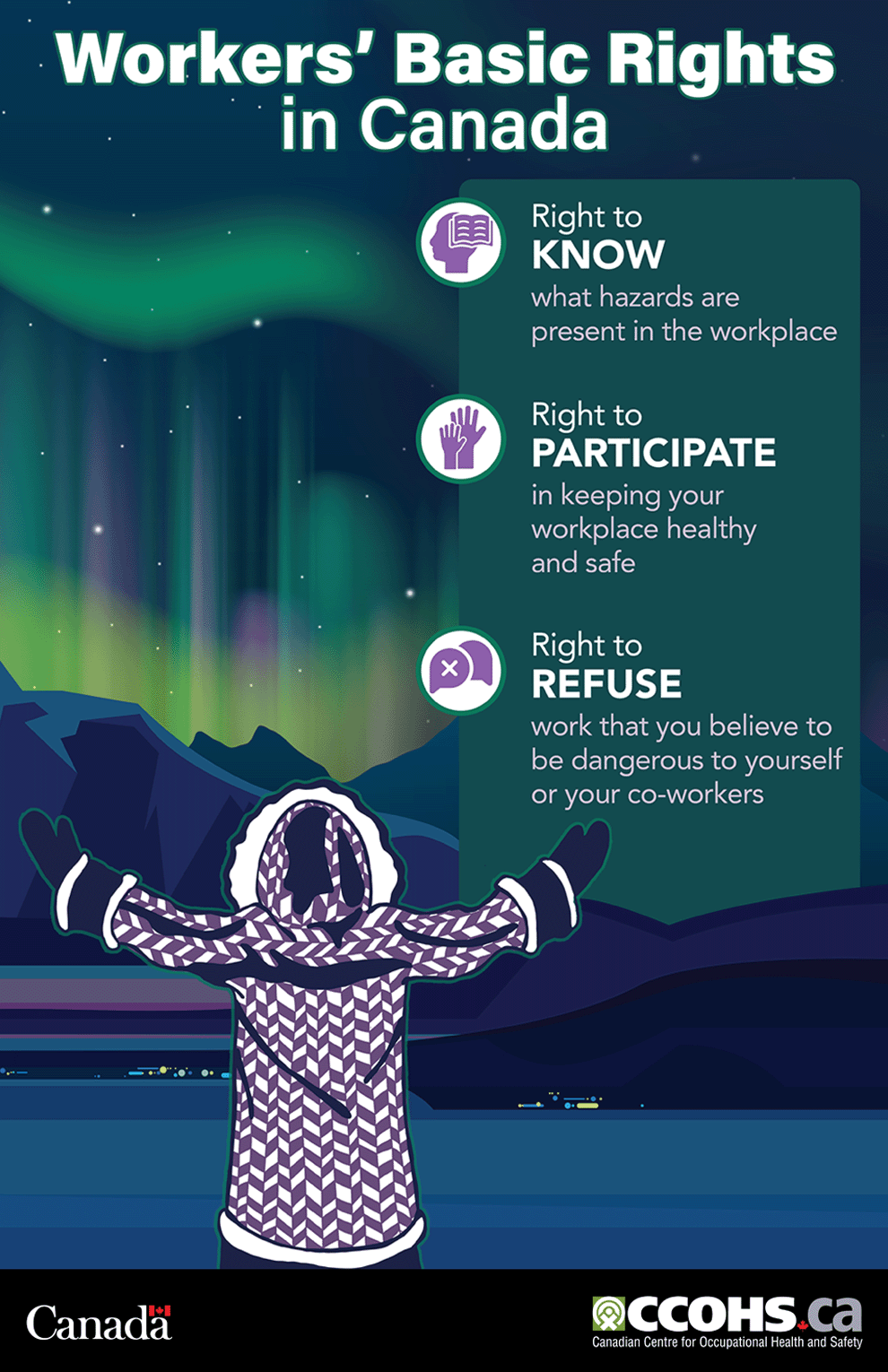Scheduled maintenance - Thursday, July 12 at 5:00 PM EDT
We expect this update to take about an hour. Access to this website will be unavailable during this time.
Partner News

Every person employed in Canada has the right to a safe work environment. Across Canada there are laws in place to protect workers on the job. Occupational health and safety legislation outlines three important rights of all workers to ensure they have the knowledge they need to be safe on the job and the freedom to participate in health and safety activities in their workplace.
New posters are available in Inuktituk and Inuinnaqtun, in addition to French and English, so employees can be made aware of their rights, and workplaces can demonstrate their commitment to health and safety.
| Inuinnaqtun | English | French | |
 |
 |
 |
 |
OSH Answers

Finding answers to your health and safety questions is easier and faster than ever. CCOHS’ OSH Answers online fact sheet collection has a new look and feel so you can quickly get the credible information you need, access helpful related content, and share with colleagues, fast. As always, these fact sheets remain free to access anytime from the CCOHS website. Some of the improvements include:
Did you know? OSH Answers fact sheet topics are based on real questions that CCOHS has received from people across Canada over the years. With over 700 fact sheets, the collection continues to grow as new questions and topics are raised by workers, their families, health and safety committee members, employers, and others.
If you don’t see the answer to your question, you can always contact CCOHS’ free Safety InfoLine service for confidential, direct assistance.
Events

Register today to get the special early bird rate for CCOHS Forum, taking place from September 26-27, 2023, in Halifax, Nova Scotia. This two-day, national workplace health and safety event brings together leaders, changemakers, and experts representing government, labour, and workplaces.
Forum focuses on the impacts of the changing world of work on health and safety. The event features perspectives on current and emerging issues, an innovation showcase to learn about new tools and resources, and opportunities to discuss and exchange ideas. Forum is designed to be an intimate event, with opportunities to interact with others who share a passion for creating healthy workplaces.
Registration includes all speaker sessions, interactive events, the innovation showcase, lunches, and light refreshments. Delegates will also have access to exclusive room rates at the venue hotel, the Westin Nova Scotian.
Be sure to register by June 15, 2023 to get the early bird rate. A student rate is also available.
For more information and to stay up-to-date, visit https://www.ccohs.ca/forum/.
Podcasts

CCOHS releases new podcasts each month to help you stay current and informed on workplace health, safety, and well-being in Canada.
New Podcast: Workplace Impacts from Climate Change
Canada is warming at roughly twice the rate of the rest of the world, and the effects are being felt in workplaces across the country. In the latest episode of Health and Safety To Go, hear from a geoscientist and climate change expert on which industries are most affected and how employers and workers can adapt.
Podcast runs: 6:41 Listen to the podcast now
Webinar
On March 22, join us for a free one-hour webinar where our panel will investigate the psychological impact of climate change, its potential threats, and measures to prevent possible hazards in our working life. Panelists include Katharina van Bronswijk, Cognitive Behavioural Therapist at Psychologists for Future, Joanna Eyquem, Managing Director at the Intact Centre on Climate Adaptation at the University of Waterloo, and Anne Tennier, President and CEO of the Canadian Centre for Occupational Health and Safety.
To register and learn more about our speakers, visit: https://us06web.zoom.us/webinar/register/WN_Z3eicBG7QWuteE8fXCahNQ
Infographic

More than 3.5 million workers in Canada are also caregivers. In partnership with McMaster University, CCOHS recently developed an infographic to help employers understand how to help caregiving workers and promote a culture where they feel open and comfortable about their caregiving responsibilities.
Workers provide care for people in their lives for many reasons, such as injuries, disabilities, aging parents, and chronic illnesses. Their caregiving responsibilities can be short or long-term. Supporting these employees benefits the workplace in several ways. It can improve morale, reduce disruption from unplanned absences, and encourage a more compassionate work environment.
Share this infographic in your workplace to help create an environment that supports caregiving employees.
Last Word

The Focus on Safety Youth Video Contest is open to all youth in Canada. To enter, create a video highlighting what workplace safety means to you. Winners will receive up to $2,000!
Make sure to check out the full contest details and note that the deadline to enter depends on which province or territory you live in. Winners will be announced in May 2023 during Safety and Health Week.
Survey

Tell us what you want to see in the newsletter and what you need to help you and others work safely.
Complete the short survey by March 31, 2023, and you could win a $100 Indigo gift card.
Take the Health and Safety Report Readership Survey.
Thank you - with your input we can make the Report better.
All responses will remain confidential, and your information will not be used for any other purpose.
On Topic

Are you up to date on the latest WHMIS legislation? In December 2022, Canada amended its Hazardous Product Regulations (HPR) to align with the 7th revised edition and certain provisions of the 8th edition of the Globally Harmonized System of Classification and Labelling of Chemicals (GHS). The amendments introduce some key changes to WHMIS that workers, employers, and suppliers need to know.
A brief history of WHMIS
WHMIS, which stands for Workplace Hazardous Materials Information System, is Canada’s national hazard communication standard. It was created in 1988 to communicate important health and safety information about the hazardous products employers and workers may be exposed to while at work. It remained relatively unchanged until 2015, when WHMIS was updated to align with the 5th edition of the Globally Harmonized System of Classification and Labelling of Chemicals (GHS). Since then, Canada’s amended legislation on WHMIS has been known as WHMIS 2015.
Key changes
WHMIS 2015 will now be referred to as just “WHMIS”, and versions of the Hazardous Products Regulations will be distinguished with the terms “former” and “amended”.
For most workplaces, the most notable impacts of the transition from WHMIS 2015 to the amended WHMIS will be the adoption of a new physical hazard class, Chemicals Under Pressure, the adoption of a non-flammable aerosols hazard category, and new subcategories for flammable gases. A full breakdown of the changes and a comparison with WHMIS 2015 is available from Health Canada (see resources).
There are also several revisions to the information elements required on safety data sheets and labels, including modifications to the required elements concerning the physical and chemical properties in section 9 of the safety data sheet. New elements were introduced, including boiling point, flammability, kinematic viscosity, density and relative density, relative vapour density and particle characteristics. Some elements were removed, including odour threshold, evaporation rate, vapour density and viscosity. A safety data sheet can still provide these information elements as additional information, as long as it is not false or misleading.
Another amendment specifies that all hazardous ingredients which are present in a mixture at concentrations above the relevant cut-off levels must be disclosed, regardless of whether the hazardous ingredient contributes to the classification of the mixture as a hazardous product or not.
Employers in every industry that uses, stores or handles hazardous products will need to update their training programs to help workers learn and understand the new WHMIS changes. However, the industries most affected are likely to be mining, quarrying and oil and gas extraction, petroleum and coal product manufacturing, chemical manufacturing, plastics and rubber products manufacturing, non-metallic mineral product manufacturing, primary metal manufacturing, and animal feed manufacturing.
Benefits
Knowledge is power when it comes to hazardous products. These amendments are designed to provide more comprehensive and detailed health and safety information on product labels and safety data sheets, which will provide better protection for workers. They also help Canada meet its international commitment under the Canada-United States Regulatory Cooperation Council Joint Forward Plan. Aligning with certain requirements of the revised editions of the GHS will also have significant trade benefits for suppliers, due to the harmonized labelling and safety data sheet requirements for workplace hazardous products.
Transition period
Suppliers have until December 14, 2025 to bring their safety data sheets and labels into compliance with the amended regulations. During this three-year transition period, regulated parties can choose to comply with either the former HPR or the amended HPR, but not both. The hazard classification, safety data sheet and label of a hazardous product must be fully compliant with the version of the regulation chosen. This means that in order for a product to be compliant with the amended WHMIS, both the safety data sheet and label must meet the requirements of the amended WHMIS.
Consult your local health and safety authority
Employer obligations for workplace hazardous products are set out in federal, provincial, and territorial occupational health and safety legislation. For information on how your jurisdiction is handling the transition period, and how you can update your health and safety procedures accordingly, contact the appropriate federal, provincial, or territorial occupational health and safety regulatory agency. You can also sign up to be notified when Health Canada publishes new WHMIS updates at whmis-simdut@hc-sc.gc.ca.
Resources
Note that CCOHS resources, including WHMIS courses, will be updated throughout the coming months to reflect these changes to WHMIS.
The Health and Safety Report, a free monthly newsletter produced by the Canadian Centre for Occupational Health and Safety (CCOHS), provides information, advice, and resources that help support a safe and healthy work environment and the total well being of workers.
You can unsubscribe at any time. If you have been sent this newsletter by a friend, why not subscribe yourself?
Concerned about privacy? We don’t sell or share your personal information. See our Privacy Policy.
CCOHS 135 Hunter St. E., Hamilton, ON L8N 1M5
1-800-668-4284 clientservices@ccohs.ca
www.ccohs.ca
© 2024, Canadian Centre for Occupational Health and Safety
Podcast
April 24
April 28
May 6-11